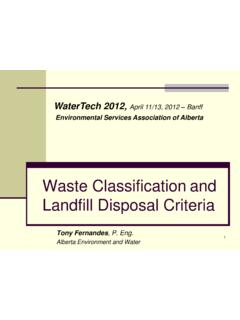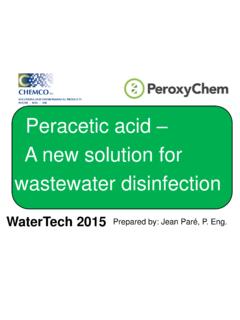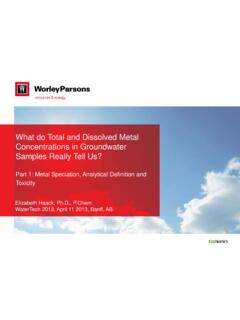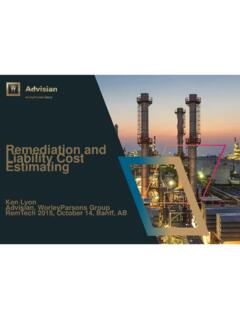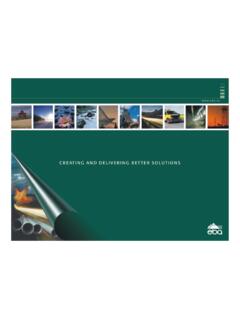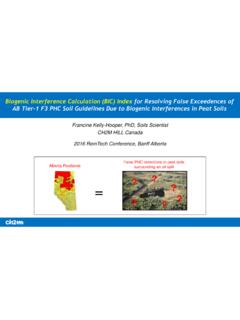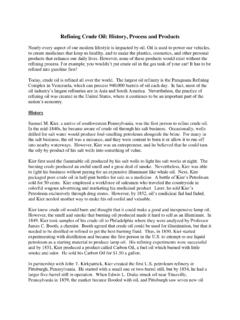Transcription of Forensic Investigations of Petroleum Hydrocarbon ...
1 Forensic Investigations of Petroleum Hydrocarbon environmental Impacts: overview & Case Studies Heather Lord, PhD A Common How much PHC is there? When the answer is unexpected you may want to learn why! Usually asked during compliance testing or for monitoring remediation progress and answered with a TPH analysis 2 Common Forensic Investigative Goals: Are there plumes co-mingling? Is this a fresh spill? How old is the NAPL? Is my client responsible? Who s leaking gasoline into the street? When did the contamination begin? Is the spill from the most recent tank nest? Is the contamination OLDER than 1992? Who can I invite to the cleanup party? 3 Keys to 1. Understand the site and the question to be answered Site History ask lots of questions Define the goal 2.
2 Employ a tiered approach to lab analysis Start with a total PHC screening test CCME Hydrocarbons Based on those results select the desired analytical approach 3. Develop multiple lines of evidence to support the conclusion 4 History Background Information Past use of the property or location Compounds of concern Geology/Geochemistry What is the nature of the soil environment? Aggressive or passive? Hydrogeology Groundwater flow Where were the samples collected? Relative to surface Relative to water table Relative to potential sources of impact Would additional samples allow for more solid conclusions? The samples in hand may have been collected for a different purpose compliance monitoring Are they appropriate for the required investigation ?
3 ? Background Information: Detective Work Gas Chromatography for Identification of Petroleum Products GC remains the most widely used technique to identify Petroleum products in the environment. Most fuels and lubricants are too complex to allow full speciation of every component. Identification/quantification of target components Visual inspection and target analytes are used as identification tools 6 Tiered Approach to Forensic Investigations 7 SCREENING: PHC (F1-F4) Volatile Extended GC/FID or GC/MS PIANO (PIONA) Total Lead (ICPMS) Alkyl Lead Characterization Semi-Volatile Extended GC/FID or GC/MS Fractionation Aliphatic - Biomarkers Aromatic Biomarkers or PA H PAH/alkylPAH 0 5 10 15 20 25 30 35 40 45 Carbon Number Gasoline (C3-C10) Naphtha (C6-C10) Kerosene/Jet Fuels (C6-C16) Diesel/Fuel Oils (C8-C24) Heavy Fuel Oils (C10-C40) Lubricating Oils (C20-C44) Crude Oils (C3-C44) Some products may span both the Volatiles and the Semi-Volatiles Petroleum Products Carbon Number Distribution 8 Gasoline Forensics 9 Determination of gasoline grade nC6 B Iso-C8 nC7 T E o-X m/p-X History.
4 LNAPL collected from sump at a refinery evaporation & water washing expected TPH screening identified gasoline Two potential sources were identified: premium vs. regular gasoline Goal: Identify the source from limited LNAPL volume, avoid extensive excavation nC8 Investigated sample Gasoline standard GC/FID (C6 C10) Supreme grade gas confirmed Regular grade OI = Investigated Sample OI = 16 Supreme grade OI = 18 Octane rating Octane Index (OI) source: Schmidt et al. environmental Forensics, 2003, 4: 75-80. Unknown product: gasoline range confirmed Extractable Hydrocarbons C10 C50 (F2 F4) Volatiles by Headspace C6 C10 (F1) Total lead = 100 g/g SS Investigated sample Diesel standard Investigated sample Gasoline standard Unknown product: PIONA & Lead Results Paramet ermass %i so-Paraffi ,2, ermass % ,2, ,3, ,3, , , and C6 OlefinsAbsentTota l Aroma ti cs (%) tesNoneTotal Lead Analysis (ICPMS): 103 g/g Lead Speciation Analysis: Tetraethyl lead: 150 g/g Triethyl lead: g/g Tetramethyl lead: <1 g/g Weathering: (isoParaffins+Naphthenes)/Paraffins - Biodegradation.
5 Ratio increases with increased biodegradation Methylcyclohexane/n-Heptane - Biodegradation: Ratio increases with increased biodegradation 3-Methylhexane/n-Heptane - Biodegradation: Ratio increases with increased biodegradation (Benzene+Toluene)/(Ethylbenzene+Xylenes) - "Waterwashing": Ratio decreases with increased dissolution Benzene/Cyclohexane - "Waterwashing": Ratio decreases with increased dissolution Toluene/Methylcyclohexane 2 - 10 "Waterwashing": Ratio decreases with increased dissolution n-Pentane/n-Heptane - Evaporation: Ratio decreases with increased evaporation 2-methylpentane/2-methylheptane 3 - 8 Evaporation: Ratio decreases with increased evaporation Refining Method: 2,2,4-Trimethylpentane/Methylcyclohexane 2 - 3 Values >5 typically represent premium grade gasoline (2,2,4-Trimethylpentane+Toluene)/ (n-Heptane+n-Octane) 2 - 5 Values increase with octane rating in unweathered samples 224 TMP/(224 TMP+223 TMP+234 TMP+233 TMP) --- typically represent HF alkylation.
6 Typically represent H2SO4 alkylation Ethylbenzene/(Ethylbenzene+Xylenes) - Ratio decreases with removal of ethylbenzene in unweathered samples n-Butane/(n-Butane+isoButane) --- Ratio increases with removal of isobutane in modern gasolines isoPentane/(isoPentane+n-Pentane) --- Isomerate blending usually results in a ratio > Naphthalene/Dodecane 1 - 3 Higher values may be indicative of gasoline reforming (2-MH+23 DMP)/(3-MH+24 DMP) --- C5 & C6 olefins Absent Produced through Fluidic Catalytic Cracking (FCC) Reformulated vs. Conventional: Benzene (wt %) <1 % Benzene content cannot exceed 1% in typical gasolines. Under aerobic conditions benzene degrades quickly Total Aromatics (wt %) <35% Typically < 30% in gasolines produced after 1999; increased aromatic content may be due to the resistance of the alkylbenzenes to weathering relative to simpler, non-aromatic hydrocarbons Oxygenates (wt.)
7 %) None Unknown product: PIONA ratio analysis minimal biodegradation, minimal dissolution, evaporation indicated These indicators are suspect in weathered gasolines!! Unknown product: gasoline grade? PIONA suggested premium grade gasoline Unreliable due to evaporation Chromatographic evaluation of grade suggested regular grade OI = Iso T C7 C8 Gasoline spike Investigated sample Conclusion: old (pre 1992) evaporated leaded regular grade gasoline Middle Distillate Forensics (Diesel Range) 16 impact of Weathering Light hydrocarbons Olefins N-Alkanes Monoaromatics Isoalkanes Parent PAH > 2-ring C1 alkyl PAH C4 alkyl PAH Triterpanes Diasteranes Aromatic Steranes Porphyrins Susceptibility to weathering Least Most Introduction to environmental Forensics, Murphy and Morrison Isoprenoid Biomarkers C17/Pristane & C18/Phytane nC18/phytane nC17/pristane #2 Diesel Fuel (fresh) 18 Isoprenoid Biomarkers C17/Pristane & C18/Phytane #2 Diesel Fuel (moderately weathered) nC17/pristane C18/phytane 19 Highly Weathered.
8 Site of Recent Truck Crash fresh diesel reference fresh diesel reference Surface soil samples from under where truck landed Excavated soil from m beneath truck F1: 0 F2: 35 g/g F3: 280 g/g F4: 0 F1: 0 F2: 44 g/g F3: 0 F4: 0 C17 norPr Pr C18 Py C19 C20 C21 C22 C17 norPr Pr C18 C19 C20 C22 C21 C23 C23 C13 C14 C15 C16 Conclusion: these F2 and F3 impacts are not due to the truck crash Using Weathering to Estimate impact Age Using weathering as an indicator of age may be subject to considerable scrutiny/uncertainty Be careful with statements like this groundwater sample contained diesel, but many of the low boiling point hydrocarbons are absent, so this is an older release What impacts weathering?
9 ( context ) Soil Environment Volume of contaminant released Time of release (one event / leak over time) Depth of spill (or depth of where the sample was collected) Subsurface conditions (oxygen content, microbiological populations) Known Catastrophic Heating Oil Release in 1990 Water wells, 60 m deep in fractured bedrock LNAPL layer 20 60 cm thick still present on top of water From CCME F2 F4 data all signatures look very similar and relatively unweathered Fresh diesel reference Release site Well North of release Well South of release Fresh Diesel Release Site N of release S of release C17/Farnesane C17/2,6,10-tmt C17/nor-Pr C17/Pristane C18/nor-Pr C18/Phytane Pristane/nor-Pr Pr/Ph Pr/2,6,10-tmt nor-Pr/Phytane nor-Pr/2,6.
10 10-tmt Pristane/Farnesane nor-Pr/Farnesane C10/C20 Known Catastrophic Heating Oil Release in 1990 Extended GC/FID confirms high similarity and minimal evidence of weathering The ratios expected to decrease with weathering trend slightly lower further from the release site Ratios expected to remain constant are generally consistent, confirming the same source Diesel release in surface water Tank Sample 1 Sample 3 Sample 2 further from source Heavier alkanes Lighter alkanes decrease with distance from source Alkane pattern is consistent with a single source release, but are these four traces really the same product?? GC/MS extracted ion trace: m/z = 57 characteristic ion of alkanes Biomarkers are chemical fossils unique tracers for Petroleum contaminants structurally very similar to natural products; chlorophyll one of the last group of compounds to degrade Isoprenoids ( pristane and phytane) are considered biomarkers GC/MS biomarker peak patterns can be used to: Evaluate degree of weathering under specific soil conditions Differentiate petrogenic and biogenic impacts Identify crude oil sources GC/MS Biomarker Analysis Diesel release in surface water (cont.)
